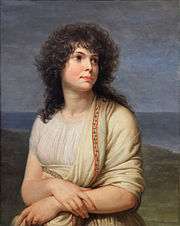Théâtre de Paris
|
Nouveau-Théâtre (1891–1918 ) Théâtre Réjane (1906–1918) Théâtre Moderne Petit Théâtre de Paris | |
 | |
| Address |
15 rue Blanche Paris |
|---|---|
| Coordinates | 48°52′43″N 2°19′53″E / 48.878603°N 2.331506°E |
| Type | theatre |
| Capacity | 1,100 (plus 300) |
| Opened | 1891 |
| Website | |
| www.theatredeparis.com | |
The Théâtre de Paris is a theatre located at 15, rue Blanche in the 9th arrondissement of Paris. It includes a second smaller venue, the Petit Théâtre de Paris.
History
The first theatre on the site was built by the Duke of Richelieu in 1730. Baron Ogny bought it in 1779 and renamed it Folie-Richelieu. Then during the First Empire it was directed by Fortunée Hamelin, a celebrated member of the Merveilleuses ("marvelous women") of the Directoire era.

In 1811, the Folie-Richelieu was transformed into a park, then demolished completely in 1851 in the redevelopment under Baron Haussmann. It became the site of the church of Sainte-Trinité de Paris with part of the site becoming a roller skating rink. In 1880, using plans by the architects Aimé Sauffroy and Ferdinand Grémailly, part of the rink became the Palace Théâtre and, after a further restoration in 1891 by Édouard Niermans, the Casino de Paris. After that, the rest of the rink, near the present rue Blanche, was demolished to make way for the Nouveau-Théâtre.
.jpg)
The first director of the Nouveau-Théâtre, actor and stage director Lugné-Poe, an associate of André Antoine, introduced the Norwegian Henrik Ibsen and the Swedish August Strindberg to Parisian audiences, before leaving to found the Théâtre de l'Œuvre in 1893.
In 1906, the actress Gabrielle Réjane bought the theater, renovated it and gave it a new name, the Théâtre Réjane. She produced among other works the French premiere of L'oiseau bleu by Maurice Maeterlinck in 1911 and successfully played her signature role of Madame Sans-Gêne by Victorien Sardou at the theatre.
The producer Léon Volterra bought the hall in 1918, and on 12 August 1919, he inaugurated the Théâtre de Paris, Réjane having stipulated in the sales contract that the theater could not retain her name. Volterra ran the theatre until 1948, when it was taken over by Marcel Karsenty and the comedian Pierre Dux. The actress and director Elvira Popescu took over in 1955 along with Hubert de Mallet, managing it for ten years, before she left to the Théâtre Marigny.
Under Alain de Leseleuc (1965–1975) and Robert Hossein (1975–1990) the theatre specialized in musical works, particularly Offenbach operettas and opéras-bouffes, such as La Périchole directed by Maurice Lehmann, La belle Hélène directed by Jérôme Savary, and Le pont des soupirs directed by Jean-Michel Ribes. It also produced musicals like Starmania and Cats.
Since January 2002, Stéphane Hillel has been artistic director of both theatres.
Petit Théâtre de Paris
Elvira Popescu created a second venue with 300 seats, converted from costume workshops, which she first called the Théâtre Moderne before renaming it the Petit Théâtre de Paris. This second theatre is still functioning.
Premières and notable productions
Nouveau-Théâtre
- 1892: Rabelais, play by Oscar Méténier
- 1894: Nos bons chasseurs, vaudeville by Charles Lecocq, text by Paul Bilhaud and Michel Carré
- 1897: Brouillard du matin, play by Jacques Copeau
- 1906: Le Réformateur, play by Edouard Rod
Théâtre Réjane
- 1908: Qui perd gagne, play by Pierre Véber
- 1911: L'Orfeo, opera by Claudio Monteverdi (first modern staged performance[1])
Théâtre de Paris
- 1929–1931: Trilogie marseillaise (first two parts: Marius and Fanny) by Marcel Pagnol, with Orane Demazis, Raimu and Pierre Fresnay
- 1948: Tovaritch by Jacques Deval, with Elvira Popesco
- 1956: Tea and Sympathy by Robert Anderson, with Ingrid Bergman
- 1961: 'Tis Pity She's a Whore by John Ford, directed by Luchino Visconti, with Romy Schneider and Alain Delon
- 1962: The Seagull by Anton Chekhov, directed by Sacha Pitoëff, with Romy Schneider
- 1967: Henri IV by Luigi Pirandello, directed by Sacha Pitoëff, with Claude Jade
- 1993: Tailleur pour dames by Georges Feydeau, with Jean-Paul Belmondo
- 1998: Variations énigmatiques by Éric-Emmanuel Schmitt, with Alain Delon
- 1999: Les portes du ciel by Jacques Attali, with Gérard Depardieu
- 1999: One Flew Over the Cuckoo's Nest after the film by Miloš Forman, with Bernard Tapie
- 2000: Becket ou l'honneur de Dieu by Jean Anouilh, with Bernard Giraudeau
- 2001: Mrs. Doubtfire after the movie from Chris Columbus, with Michel Leeb
- 2005: Amadeus by Peter Shaffer, with Lorànt Deutsch and Jean Piat
- 2008: On Golden Pond by Ernest Thompson, with Jean Piat, Maria Pachomius and Beatrice Agenin
- 2011: Peter Pan by J. M. Barrie, director Irina Brook
References
- ↑ Fortune and Whenham, "Modern editions and performances" pp. 173–181
- Fortune, Nigel; Whenham, John (1986). "Modern editions and performances" in Whenham, John (ed.): Claudio Monteverdi: Orfeo. Cambridge, England: Cambridge University Press. ISBN 0-521-24148-0.
- Goetschel, Pascale and Yon, Jean-Claude: Directeurs de théâtre, XIXe–XXe siècles: Histoire d'une profession, Sorbonne, 2008
- Hobson, Harold: French Theatre Today 1953, Arno Press
- Labourdette, Jean-Paul: Le Petit Futé Paris Spectacles p 134
- This article includes information translated from the French Wikipedia equivalent.